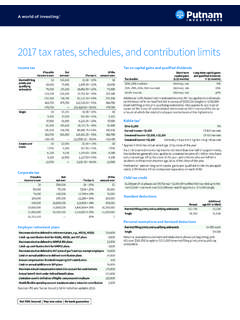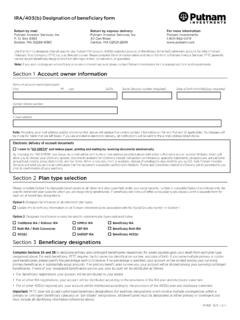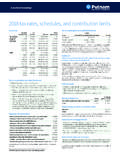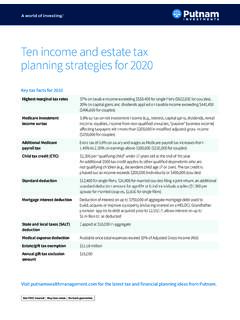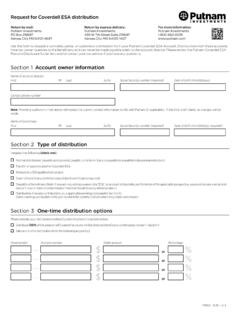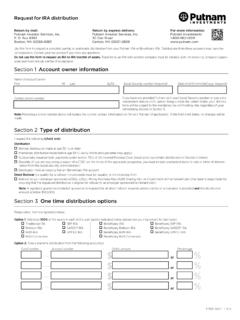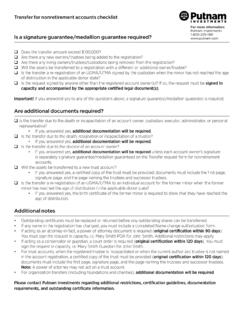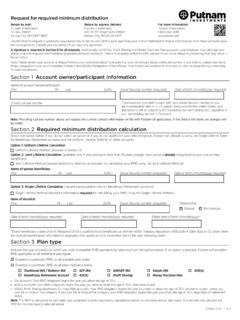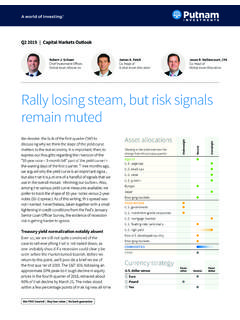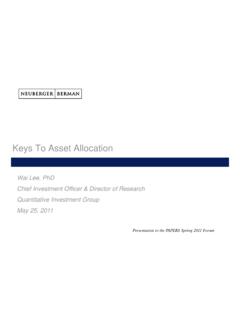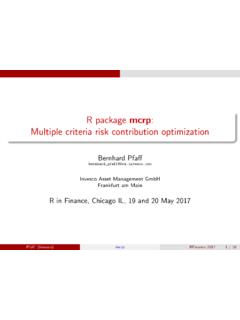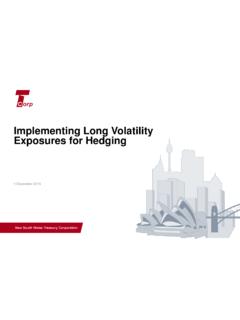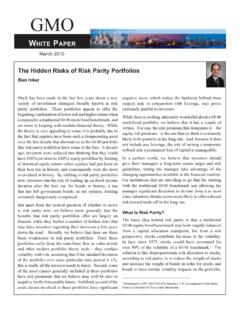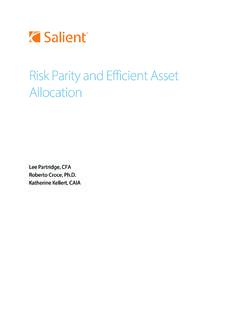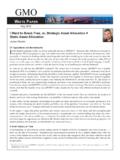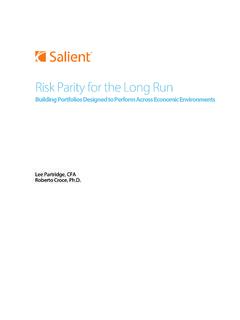Transcription of The glide path less traveled white paper - putnam.com
1 For investment professional use only. Not for public takeawaysThis paper defines key assumptions, derived from empirical data, to deliver highly accurate and representative simulations of participant paper constructs an alternative glide path design that we believe more efficiently balances major retirement savings risks longevity/shortfall, return sequence, and inflation than the industry average glide path. The paper demonstrates that an alternative glide path one that begins with higher equity allocations than the industry average, follows a steeper slope of asset shifts, and arrives at a risk- parity solution at the point of retirement has less variability in outcomes than the industry glide path less traveledA critical examination of assumptions, outcomes, and glide path specificationBrett Goldstein, CFAP ortfolio ManagerApril 2018 | putnam PerspectivesPutnam Investments | glide path less traveled A critical examination of assumptions, outcomes, and glide path specificationFor investment professional use only.
2 Not for public Investments | glide path less traveled A critical examination of assumptions, outcomes, and glide path specificationExecutive summarySuccessful glide path design must marry accurate estimation of quantitative inputs with efficient risk management. Using the most representative set of assumptions for the broadest segment of the plan participant demographic, we employ simulations to relate these assumptions to outcomes for the industry average glide philosophy on glide path construction is that the main goal of a glide path is to provide adequate wealth throughout retirement. For this reason, our simulations target whether or not an individual would have enough retirement income to reach life expectancy age with a non-zero portfolio risk and shortfall risk are primarily the result of not accumulating enough retirement savings, either as a result of insufficient savings or inadequate risk-taking.
3 Sequence risk, on the other hand, is the result of taking too much risk, allowing the order of market returns to damage a portfolio that is in the process of de-risking. These risks are constantly at odds with each other, and a well-designed glide path must balance these risks appropriately throughout the glide path. We also consider the impact of inflation risk, but we find little compelling evidence that this should play a major role in glide path design, aside from using real returns, rather than nominal returns, in our high success rates for the industry average glide path, we find the simulated results to suggest potential inefficiencies in approaching the retirement savings problem. The industry average glide path does too little to combat longevity/shortfall risk early in the glide path, and it fails to fully defend against sequence risk late in the glide provide an alternative glide path specification, which is steeper than the industry average.
4 Our alternative is fully invested in equity at the start of the glide path, has a higher equity allocation for 25 years, and then more steeply reduces the equity allocation to arrive at a risk- parity solution at industry average, relative to our calculated alternative, has a slightly higher probability of success, along with higher mean and median values at retirement. But those gains are the result of more variability in the distribution of portfolio values at retirement. Much of the higher variability manifests with higher portfolio values on the right half of the distribution, where retirees will easily be able to meet their need in retirement, but with that higher variability also comes a higher probability of landing a plan participant in the far left tail of the distribution a poor tradeoff in our this reason, we find solace in the lower variability of outcomes that result from the alternative portfolio.
5 Much of the probability distribution is clustered around an acceptable outcome, and even if the retirement portfolio value comes up short, it is likely to be only a little short. In these scenarios, slight changes in retirement spending can easily make up for the savings shortfall. Only the most significant deficits, which are more likely to occur in the higher-risk glide path, leave unfortunate retirees with few , it is worth considering the outcomes outside the scope of a binary simulation. In reality, failure is not binary, and no matter the outcome, plan participants must make the best of their Investments | glide path less traveled A critical examination of assumptions, outcomes, and glide path specificationFor investment professional use only. Not for public planning is a daunting task.
6 The complex relationships and the uncertainty between assumptions such as capital markets returns, life expectancy, savings rate, income replacement rate, and real income growth rate are more than enough to make a plan participant anxious. And while existing analysis has yielded some general rules to follow, we believe there is a dearth of research identifying the right assumptions to use and relating these assumptions back to the construction of a glide recognize that assumptions might change over time. Annual Morningstar Target-Date Fund Landscape reports1 show that target-date mutual fund assets have grown to almost $900 billion at the end of 2017 from a base of less than $100 billion in 2005. Throughout this period of rapid growth, capital markets and investment management in general, and retirement products in particular, have changed drastically.
7 In fact, at the start of that period plan participants could not be auto-enrolled nor was there the ability to auto-escalate savings rates, both of which were enabled by the Pension Protection Act (PPA), passed in 2006. The PPA has proven to be a watershed moment in the development of retirement savings, and it has empowered plan sponsors and plan participants to better prepare for a successful the following paper , we seek to determine what the right assumptions are for glide path design today. Once our set of baseline assumptions has been selected, we estimate outcomes and relate these assumptions to the risks that must be addressed by the glide path. Next, we consider where the investment manager, as it relates to the shape of the glide path, has the greatest ability to improve the outcomes for the plan participants.
8 Finally, we identify additional considerations that are difficult to simulate but important to incorporate into retirement and philosophy2 Our philosophy of glide path construction is that the main goal of a glide path is to provide adequate wealth throughout retirement. We therefore define success as the ability of a plan participant to reach life expectancy with a positive portfolio balance. Thus, we are indifferent with respect to higher portfolio values if the probability of reaching life expectancy with a positive portfolio balance is essentially assumptions driving glide path construction are of critical importance, so they should represent the greatest proportion of the population that will engage with a glide path. In this regard, we seek out the central tendency of a given distribution when defining our glide path assumptions, as this should logically be the basis for the strategic glide path.
9 We expect that deviations from these assumptions will be minimized overall by using their central tendencies and will have a limited impact on the outcome of a plan participant, recognizing, of course, that a glide path is neither intended nor suited to meet the needs of the individuals in the far tails of a 2015: 2017: This paper assumes some familiarity with glide path research. For background on these topics, please see Optimizing the glide path for a smoother landing in retirement Investments | glide path less traveled A critical examination of assumptions, outcomes, and glide path specificationFor investment professional use only. Not for public is also important to recognize that some aspects of retirement planning are outside the control of the glide path and of the portfolio manager, such as plan sponsor match incentives, participant savings rates, and income or debt outside of retirement accounts.
10 No matter the choice of glide path, individuals will never have enough wealth at retirement if they save too little. Instead, we must build the glide path to address the risks that can be helped by an effective glide path, and we have employed Monte Carlo simulations to allow us to compare the costs and benefits of the various stated earlier, the goal of a glide path is to provide adequate investment such that retirees do not consume all of their savings in their lifetime. Although we think of this as a singular goal, there are actually two embedded goals that must be considered separately: building enough wealth during the accumulation phase before retirement and retaining enough wealth during the distribution phase in two goals, of course, are not independent.
